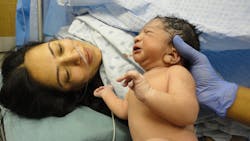Postpartum hemorrhage cart and medication kit interventions improve response to leading cause of maternal morbidity
A new study in the February 2022 issue of The Joint Commission Journal on Quality and Patient Safety, “Development of an Obstetric Hemorrhage Response Intervention: The Postpartum Hemorrhage Cart and Medication Kit,” details how a labor and delivery (L&D) unit implemented these two interventions to reduce the time and distance traveled to obtain materials necessary to treat Postpartum hemorrhage (PPH.
PPH)is the leading cause of maternal morbidity in the United States. Delayed treatment of PPH, including due to the lack of proximity of essential supplies and medications, can lead to significant blood loss and increased morbidity and mortality. The researchers created a simulation dictating the collection of a prespecified list of supplies commonly used in response to PPH. Baseline data were collected, and then Lean Six Sigma tools were used to construct a process map, including recording times and cumulative distance traveled to collect each item. The simulation was repeated after developing, creating and deploying two interventions:
· Intervention 1: A cart containing the supplies most used in response to PPH.
· Intervention 2: A medication kit with a refrigerated box of all medications typically administered during PPH.
The average time to collect a prespecified list of supplies and medication in response to a PPH scenario was 11 minutes 5 seconds, with an average cumulative distance traveled of 4,092 feet. Following Intervention 1, the time decreased to 4 minutes with 918 feet traveled; and following Intervention 2, the time further decreased to 2 minutes 14 seconds with 462 feet traveled. This represents a 79.8% reduction in time and an 88.7% reduction in distance from baseline to postintervention – optimizing the ability to efficiently treat PPH. Also, to address maternal health, The Joint Commission implemented 13 new elements of performance to improve the quality and safety of care of women during all stages of pregnancy and postpartum. The Joint Commission also began publicly reporting hospital performance on two perinatal care measures last year.
